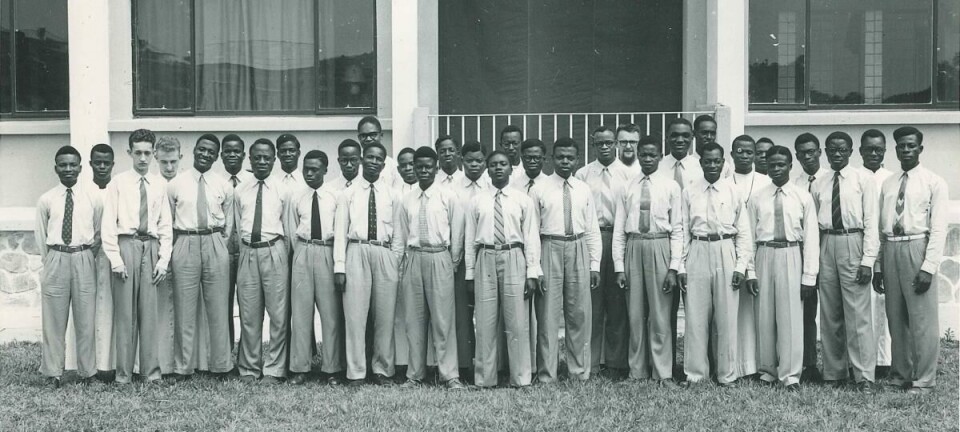article> Leuven Life
Studying at Campus Congo

When you visit Pangaea, you literally walk over the flag of the Belgian-Congo. A souvenir of the presence of our university in the colony. But what did our alma mater actually do there?
Originally written in Dutch for Veto by Kaatje Roelant and Ellen D’Hoore
Translated to English for The Voice by Gwynne van Kaauwen
Originally published on October 25, 2017
“You might not have noticed, but when you enter this building through the main entrance on the Vesaliusstraat, you are walking over the flag of the Belgian-Congo.” With these words professor Emmanuel Gerard opened the panel discussion two weeks ago concerning the colonial history of Home Vesalius. The building, now the intercultural meeting centre known as Pangaea, used to serve as a residence for the children of colonials.
Those who attended the panel conversation in Home Vesalius, know by now that the history of Belgian-Congo and our university are deeply intertwined. Ruben Mantels, researcher at UGent, confirms that already since the nineteenth century there were relations between the colony and the university. There were students who went there and the colonies were also included in the educational programs in Leuven. In the 1920s, the foundations FOMULAC (Fondation Médicale de l'Université de Louvain au Congo) and CADULAC (‘Centres Agronomiques de l’Université de Louvain au Congo’) were established as education centres overseas of the university, where agricultural and medical education was offered to the native population. Both foundations belonged to the highest educational level in Belgian Congo.
Finally, in 1954 a full-fledged campus appeared. Lovanium was founded as a department of the Catholic University of Leuven and was named after the city. “Lovanium was a real extension of the Leuven university. The amount of students was initially very limited because also the secondary education in Congo was in its infancy. In the first couple of years a few dozen Congolese students studied at Lovanium. But around the end of the ‘50s, there were about 500 students enrolled, of whom three quarters were Africans,” according to professor Emmanuel Gerard (currently a professor at the Faculty of Social Sciences, Centre for Political Research of KU Leuven).
"Lovanium was a real extension of the Leuven university"
“Independence was approaching. Belgium was not yet ready for this, but at the university a new wind was noticeable,” says professor Gerard. “The university, which had engaged in a paternalistic colonial civil project from the beginning, was more willing to accept new realities than other parts of Belgian society after WWII. Professors and students were open to a change of mentality. With the impulse of a few young professors, Leuven even played a part in the early emancipation movement of the colony.”
However, professor Idesbald Goddeeris (history professor at KU Leuven) also noted that the foundation of Lovanium was a way of profiling within the Belgian politics. During that period public universities were founded in Congo as well and Belgium was in the middle of the School War. So, the provision of Catholic education there can also be seen as a prestige project.
Sunshine and rainbows?
Colonial history is not the prettiest part of Belgian history, to put it mildly. For that reason there are also voices that say that the aim of the mission might have been education, but that in reality this was limited to preparing the local population for manual labor and thereby reinforcing colonial exploitation. The government invested very little in education and compared to other colonies, the situation in Congo was poor. With that background, the arrival of Lovanium was a big step forward.
A participatory initiative, but water under the bridge.
Remnants in the streets
Bernadette Michels, a city guide in Leuven, was raised in the residential area of Lovanium as the daughter of a professor. In her opinion the entire project was mainly driven by engaged idealists. They put in visible efforts to adjust the content of the courses to the local population. There was also emphasis on good living conditions for both students and workers. With the approaching independence, more and more Congolese employees were hired, to make sure the university’s survival was guaranteed. A participatory initiative, but water under the bridge.
Of course it is important to keep emphasising that all of this fitted within a colonial, paternalistic vision. Even though the motivation and the goodwill of the organisation of this project was definitely present, the broad context can surely not be justified.
"The history is there, and it is allowed to, or even required to know about it"
When we think back to the remnants of this colonial past that can be found in the streets of Leuven, the question remains: “How to approach this?” According to Mrs. Michels these can certainly remain. “There could be even more. Obviously not to praise ourselves. But the history is there, and it is allowed to, or even required to know about it.”
She understands completely that this is not about a beautiful chapter of our past, but she thinks it’s a pity that this period is always reviewed as doom and gloom. She remembers the atmosphere of enthusiasm and the drive that prevailed on the campus and sees this as a stark contrast with the almost suppressed history that now remains.





